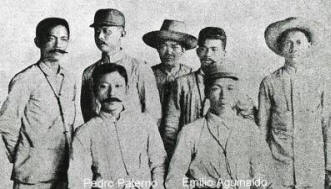Emilio Aguinaldo established his headquarters in Biak-na-Bato in Bulacan province. The news immediately spread throughout the country, and the revolutionaries were once more in high spirits. General llanera, who was in Nueva Ecija, declared his support for Aguinaldo. In July 1897, Aguinaldo established the Biak-na-Bato Republic and issued a proclamation stating the following demands:
▪ Expulsion of the friars and the return of the friar lands to the Filipinos
▪ Representation of the Philippines in the Spanish Cortes
▪ Freedom of the press and of religion
▪ Abolition of the government’s power to banish Filipinos
▪ Equality for all before the law.
A charter based on the Cuban Constitution was also drafted by Felix Ferrer and Isabelo Artacho. It was signed on November 1, 1897. The Biak-na-Bato Constitution provided for the establishment of a Supreme council that would serve as the highest governing body of the Republic. It also outlined certain basic human rights, such as freedom of religion, freedom of the press, and the right to education. Emilio Aguinaldo and Mariano Trias were elected Supreme Council president and vice president, respectively.
The Pact of Biak-na-Bato
Pedro Paterno, a Spaniard born in the Philippines volunteered to act as negotiator between Aguinaldo and Gov. Primo de Rivera  in order to end the clashes. Paterno’s effort paid off when on, December 15, 1897, the Pact he sign the Pact as the representative of the revolutionaries, and de Rivera as the representative of the Spanish government. The Leaders are: Emilio Aguinaldo-President, Mariano Trias-Vice President, Antonio Montenegro-Secretary, Baldomero Aguinaldo-Treasurer, and Emilio Riego de Dios.
in order to end the clashes. Paterno’s effort paid off when on, December 15, 1897, the Pact he sign the Pact as the representative of the revolutionaries, and de Rivera as the representative of the Spanish government. The Leaders are: Emilio Aguinaldo-President, Mariano Trias-Vice President, Antonio Montenegro-Secretary, Baldomero Aguinaldo-Treasurer, and Emilio Riego de Dios.
On December 23, 1897, Generals Celestino Tejero and Ricardo Monet of the Spanish army arrived in Biak-na-Bato and became hostages of the rebels. A ceasefire was declared by both camps and an agreement between Aguinaldo and the Spanish forces was made -that the Spanish government will grant self-rule to the Philippines in 3 years if Aguinaldo went to exile and surrender his arms. In exchange, Aguinaldo will receive P800,000 (Mexican Pesos) as remuneration to the revolutionaries and an amnesty. After receiving a partial payment of P400,000, Aguinaldo left for Hong Kong on December 27, 1897. Some Filipino generals, however, did not believe in the sincerity of the Spaniards. They refused to surrender their arms. Nevertheless, the Te Deum was still sung on January 23, 1898.
The Pact Fails
The Filipino’s and the Spaniards did not trust each other. As a result, periodic clashes between the two groups still took place even after Aguinaldo’s departure from the country. The Spanish did not pay the entire agreed amount.

2 comments:
I believe that this is an outright selling of the revolution because Aguinaldo left the Philippines but the Spaniards did not pay the full amount.
It may also have been a strategy of Emilio Aguinaldo because after this event, the declaration of Philippine Independence took place.
Post a Comment